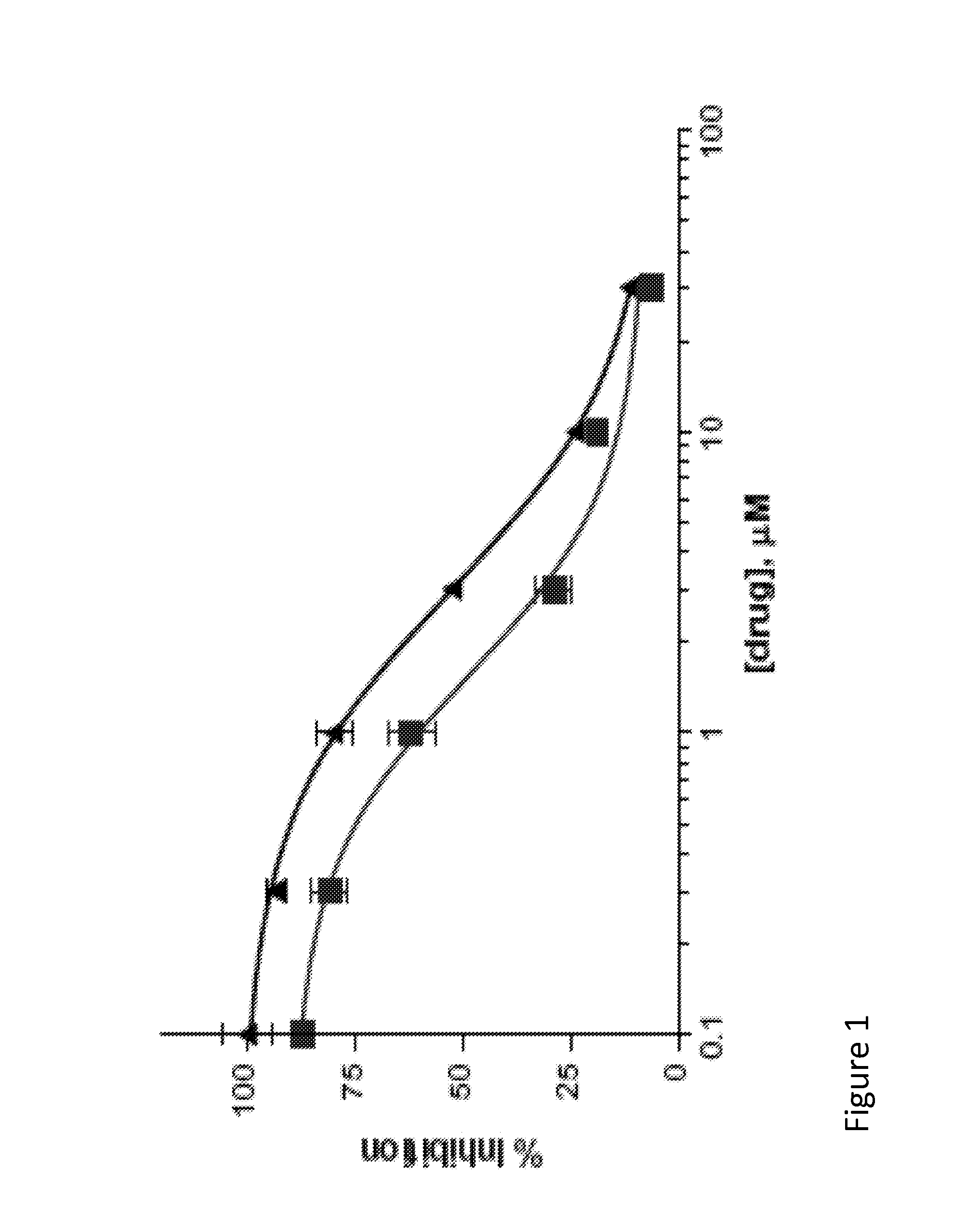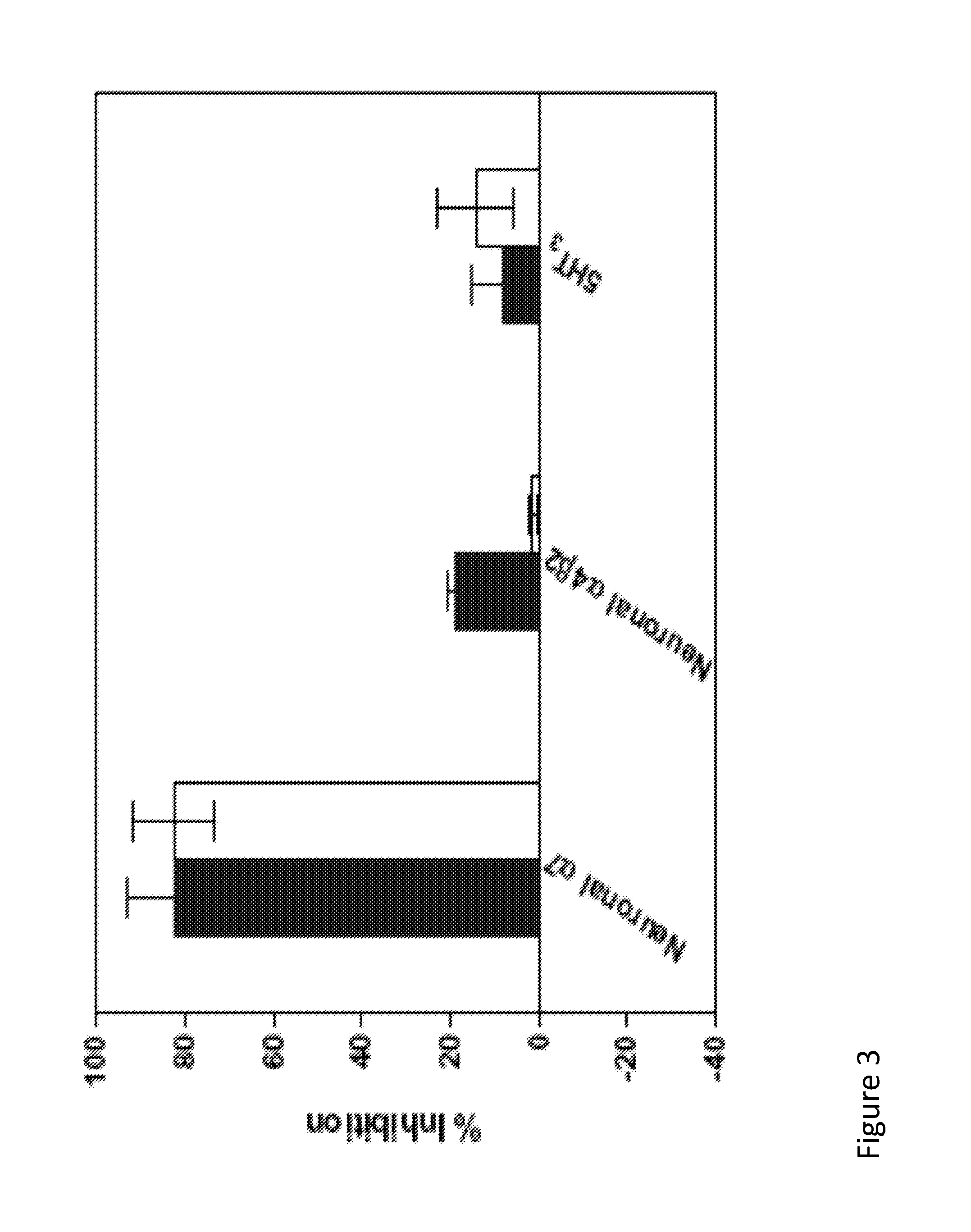Compounds and methods of prophylaxis and treatment regarding nicotinic receptor antagonists
a technology of nicotinic receptor and compound, which is applied in the direction of antinoxious agents, drug compositions, antibody medical ingredients, etc., can solve the problems of nerve agent toxicity, achieve the effects of enhancing cognition, reducing desensitization in response, and enhancing the effect of endogenous acetylcholin
- Summary
- Abstract
- Description
- Claims
- Application Information
AI Technical Summary
Benefits of technology
Problems solved by technology
Method used
Image
Examples
example 1
[0092]The structures of Compound 1 and 2 were confirmed by UPLC-HRMS and found to have purities of 98% and 97%. Several analogs of Compounds 1 and 2, with different substitutions at positions of R1, R2, R3, and R4, were identified by substructure searches or chemical synthesis (Tables 1 and 2). Structure-activity relationships (SARs) were developed for both compounds using the binding assay. For example, substitution (e.g., methyl and chlorine) at R3 is tolerated for analogs of Compound 1. Both benzyl (1i) and isobutyl (1k) at R1 were more favorable than the more flexible phenethyl (1d).
[0093]For analogs of Compound 2, a bulky benzyl group at R1 yielded more potent receptor binding than a less bulky methyl or free base (2 vs 2h and 2i). More hydrophobic substitutions at R3 improved receptor binding (2f vs 2h). The R4 position tolerated different substitutions (e.g., hydrogen and halogen).
TABLE 1Percent inhibition atR1R2R310 μMa (mean ± SD)BenzylH3-Cl83.0 ± 1.7BenzylH70.5 ± 3.1Phenet...
example 3
[0097]Binding assay was performed according to the previously reported method noted in Meyer, E. M.; Kuryatov, A.; Gerzanich, V.; Lindstrom, J.; Papke, R. L. J. Pharmacol. Exp. Ther. 1998, 287, 918. using [125I]a-BTX as the radioligand. 28 IC50 of Compound 1=1.6 1M; IC50 of Compound 8=2.9 1V. Dose-response curves of compounds 1 and 2 on the native neuronal α7 nAChR in rat brain membranes. The error bars indicate the standard deviation of the measurements. FIG. 1 details a representative dose response curves of Compound 1 and Compound 2 on the native neuronal alpha-7 nAChR in rat brain membranes. The line containing square-point designations indicates percent inhibition results regarding Compound 1, while the line containing triangle-point designations indicates the results regarding Compound 2.
example 4
[0098]The functional activity of compounds 1, 1i, and 2 is determined by electrophysical experiments on Xenopus oocytes expressing human alpha-7 nAChR. Human alpha-7 nAChR may be expressed in Xenopus oocytes by any means to known in the field. These three compounds are found to inhibit acetylcholine-evoked receptor responses in a dose-dependent manner, suggesting the subject compounds are α7 nAChR antagonists. The IC50 values of 1, 1i, and 2 are 11.9 μM, 3.7 μM, 18.9 μM, respectively. The α7 functional potency was 6-8 fold lower than the affinity estimated from human α7 receptor binding, and this difference may come from interspecies variation (rat vs. human), or variability in receptors (native vs. recombinant), or due to technical aspect of the functional assay in the oocyte expression system. FIG. 2 illustrates the inhibition of human α7 AChR responses expressed in Xenopus oocytes. The line containing solid square-point designations indicates percent inhibition results regarding ...
PUM
| Property | Measurement | Unit |
|---|---|---|
| pH | aaaaa | aaaaa |
| diameter | aaaaa | aaaaa |
| diameter | aaaaa | aaaaa |
Abstract
Description
Claims
Application Information
 Login to View More
Login to View More - R&D
- Intellectual Property
- Life Sciences
- Materials
- Tech Scout
- Unparalleled Data Quality
- Higher Quality Content
- 60% Fewer Hallucinations
Browse by: Latest US Patents, China's latest patents, Technical Efficacy Thesaurus, Application Domain, Technology Topic, Popular Technical Reports.
© 2025 PatSnap. All rights reserved.Legal|Privacy policy|Modern Slavery Act Transparency Statement|Sitemap|About US| Contact US: help@patsnap.com



